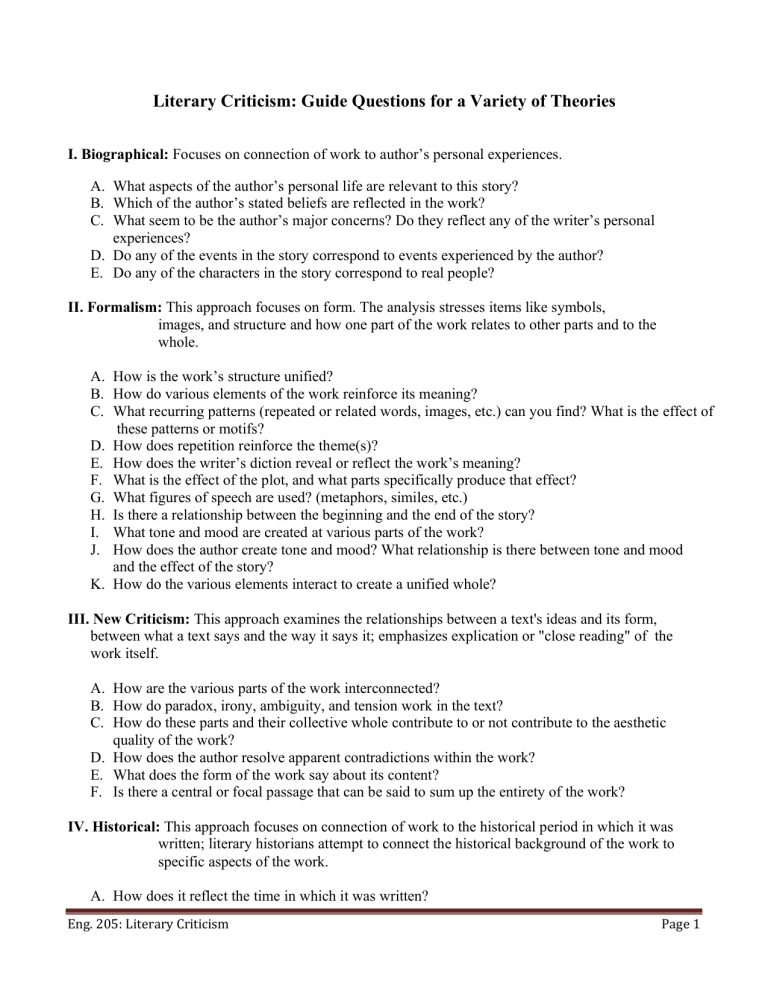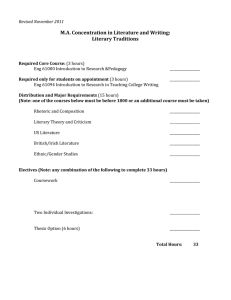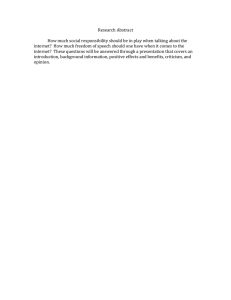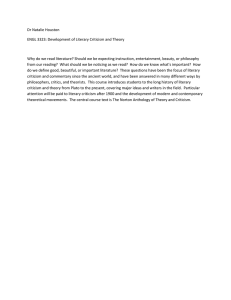
Literary Criticism: Guide Questions for a Variety of Theories I. Biographical: A. B. C. beliefs are reflected in the work? experiences? D. Do any of the events in the story correspond to events experienced by the author? E. Do any of the characters in the story correspond to real people? II. Formalism: This approach focuses on form. The analysis stresses items like symbols, images, and structure and how one part of the work relates to other parts and to the whole. A. structure unified? B. How do various elements of the work reinforce its meaning? C. What recurring patterns (repeated or related words, images, etc.) can you find? What is the effect of these patterns or motifs? D. How does repetition reinforce the theme(s)? E. F. What is the effect of the plot, and what parts specifically produce that effect? G. What figures of speech are used? (metaphors, similes, etc.) H. Is there a relationship between the beginning and the end of the story? I. What tone and mood are created at various parts of the work? J. How does the author create tone and mood? What relationship is there between tone and mood and the effect of the story? K. How do the various elements interact to create a unified whole? III. New Criticism: This approach examines the relationships between a text's ideas and its form, between what a text says and the way it says it; emphasizes explication or "close reading" of the work itself. A. How are the various parts of the work interconnected? B. How do paradox, irony, ambiguity, and tension work in the text? C. How do these parts and their collective whole contribute to or not contribute to the aesthetic quality of the work? D. How does the author resolve apparent contradictions within the work? E. What does the form of the work say about its content? F. Is there a central or focal passage that can be said to sum up the entirety of the work? IV. Historical: This approach focuses on connection of work to the historical period in which it was written; literary historians attempt to connect the historical background of the work to specific aspects of the work. A. How does it reflect the time in which it was written? Eng. 205: Literary Criticism Page 1 B. How accurately does the story depict the time in which it is set? C. What literary or historical influences helped to shape the form and content of the work? D. How does the story reflect the attitudes and beliefs of the time in which it was written or set? (Consider beliefs and attitudes related to race, religion, politics, gender, society) E. What historical events or movements might have influenced this writer? F. Does the story reveal or contradict the prevailing values of the time in which it was written? G. How important is it the historical context (the work and the reader) to interpret the work? V. Marxism: business. A. What is the relationship between the characters and their society? B. Does the story address societal issues, such as race, gender, and class? C. How do social forces shape the power relationships between groups or classes of people in the D. Does the story address issues of economic exploitation? What role does money play? E. How do economic co F. Does the work challenge or affirm the social order it depicts? G. How does the microcosm (small world) of the story reflect the macrocosm (large world) of the society in which it was composed? H. Do any of the characters correspond to types of government, such as a dictatorship, democracy, communism, socialism, fascism? What attitudes toward these political structures/systems are expressed in the work? VI. Deconstruction: It is a method of reading which is based on the assumption that language is unreliable. The goal of a deconstructionist reading is to seek out the contradictions in the text to prove that the text lacks unity and coherence. The point isn't really to show that the text means the opposite of what it is supposed to mean, but that there can be no actual interpretation of the text. Although deconstruction is primarily applied to the written word, some practitioners use deconstructive techniques to analyze concepts, systems and institutions. A. B. C. D. E. F. G. H. I. J. What is the relationship of the title to the rest of the work? What words need to be defined? What relationships or patterns do you see among any words in the text? What are the various connotative meanings words in the text may have? What allusions, if any, are in the text? What symbols, images, and figures of speech are used? What elements of prosody can you note and discuss? What is the tone of the work and from what point of view is it being told? What tensions, ambiguities, or paradoxes arise within the text? How do all the elements of the text support and develop the overall theme? Eng. 205: Literary Criticism Page 2 VII. Archetypal: This approach focuses on connections to other literature, mythological/biblical allusions, archetypal images, symbols, characters, and themes. A. How does this story resemble other stories in plot, character, setting, or symbolism? B. Are patterns suggested? Are seasons used to suggest a pattern or cycle? C. Does the protagonist undergo any kind of transformation, such as movement from innocence to experience, that seems archetypal? D. Are the names significant? E. Does the writer allude to biblical or mythological literature? For what purpose? F. What aspects of the work create deep universal responses to it? G. How does the work reflect the hopes, fears, and expectations of entire cultures? H. How do myths attempt to explain the unexplainable: origin of man? Purpose and destiny of human beings? I. What common human concerns are revealed in the story? J. How do stories from one culture correspond to those of another? (For example, creation myths, flood myths, etc.) K. How does the story reflect the experiences of death and rebirth? L. What archetypal events occur in the story? (Quest? Initiation? Scapegoating? Descents into the underworld? Ascents into heaven?) M. What archetypal images occur? (Water, rising sun, setting sun, symbolic colors) N. What archetypal characters appear in the story? (Mother Earth? Femme Fatal? Wise old man? Wanderer?) O. What archetypal settings appear? (Garden? Desert?) P. How and why are these archetypes embodied in the work? VIII. Psychological/Psychoanalytic: This approach focuses on the psychology of characters. A. B. C. D. E. F. G. H. I. J. What forces are motivating the characters? Which behaviors of the characters are conscious ones? Which are unconscious? What conscious or unconscious conflicts exist between the characters? Given th Are the theories of Freud or other psychologists applicable to this work? To what degree? Do any of the characters correspond to the parts of the tripartite self? (Id, ego, superego) What roles do psychological disorders and dreams play in this story? Are the characters recognizable psychological types? How might a psychological approach account for different responses in female and male readers? K. personal psychology? L. M. N. IX. Feminism: This approach examines images of women and concepts of the feminine in myth and literature; uses the psychological, archetypal, and sociological approaches; often focuses on female characters who have been neglected in previous criticism. Eng. 205: Literary Criticism Page 3 Feminist critics attempt to correct or supplement what they regard as a predominantly male-dominated critical perspective. A. B. Is the form and content of the work influenced by the C. How do male and female characters relate to one another? Are these relationships sources of conflict? Are these conflicts resolved? D. Does the work challenge or affirm traditional views of women? E. How do the images of women in the story reflect patriarchal social forces that have impeded F. What marital expectations are imposed on the characters? What effect do these expectations have? G. What behavioral expectations are imposed on the characters? What effect do these expectations have? H. If a female character were male, how would the story be different (and vice versa)? I. How does the marital status of a character affect her decisions or happiness? X : This approach focuses on the reading process. The thoughts, ideas, and experiences a reader brings to the text, combined with the text and experience of reading it, work together to create meaning. A. Who is the reader? Who is the implied reader? B. What experiences, thoughts, or knowledge does the text evoke? C. What aspects or characters of the text do you identify or disidentify with, and how does this process of identification affects your response to the text? D. What is the difference between your general reaction to (e.g., like or dislike) and reader-oriented interpretation of the text? XI. QUEER: This approach centers of understanding, and practical orientations that make heterosexuality seem not only coherent organized as a sexuality but also . that is, A. How are binaries male/female and masculine/feminine being defined? B. Who attributes masculine or feminine qualities to whom? C. How is gender being ascribed? D. Are the critical assumptions of essentialism or social constructivism established? By what character(s)? E. F. Is gender performative? H. What social forces or constructs determine sexual identity? I. What is queer about the text? J. Is any character in crisis concerning his or her sexual identity? Eng. 205: Literary Criticism Page 4 XII. MIMETIC: This approach views the literary work as an imitation, or reflection, or representation of the world and human life, and the primary criterion applied to a work is the "truth" of its representation to the subject matter that it represents. A. B. C. How well does the text align with the real world? How accurately does the text portray real life? Is the text a true imitation, reflection, or representation of the reality of the world and of human life and character? Eng. 205: Literary Criticism Page 5


